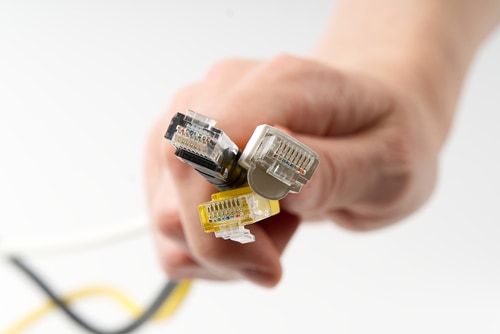This site contains affiliate links to products. We may receive a commission at no cost to you, for purchases made through these links. We are a participant in the Amazon Services LLC Associates Program, an affiliate advertising program designed to provide a means for us to earn fees by linking to Amazon.com and affiliated sites.
Table of Contents
How to Choose the Best Ethernet Cable for Your Business?
Your business place requires speedy work delivered within and before allotted deadlines. Most of this work requires a stable and reliable connection.
Whether the work is as simple as transferring or sending meeting files or uploading sales and marketing reports to the local business server, your business needs to have the best ethernet cable to carry out these tasks.
The best ethernet cable type and category has a better speed and performance than the other ethernet cables. Whichever ethernet cable you choose also affects the quality of your internet connection.
Businesses prefer wired connections over wireless ones as they are less likely to include interference. The wrong ethernet cable could disrupt and become a hindrance in performing even the daily necessary tasks.
This post will discuss the differences between two of the most used ethernet cables: Cat5e and Cat6. We will also discuss which one is the best ethernet cable for your business. Although both can feature shielding, one of these ethernet cables provides better options for a quality network connection than the other.
Below I will touch on Cat6a and Fiber optic cables as well.
What is a Cat5e Ethernet Cable?
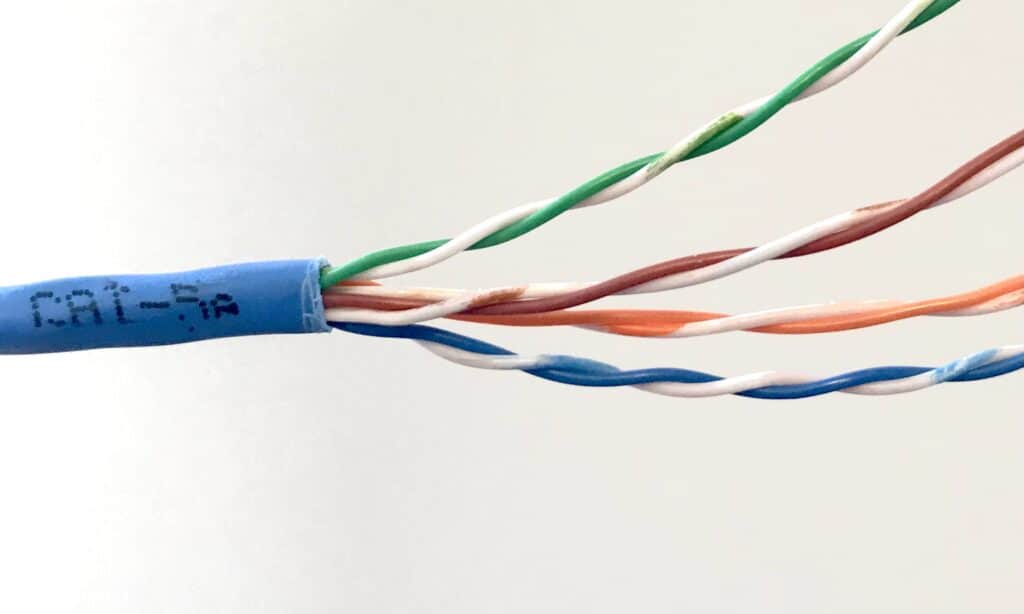
CAT simply stands for Category. So, Cat5e means Category 5 enhanced. Approved as a network cable standard in 1999, Cat5e delivers better performance than its previous Cat5 variant.
Cat5e has almost ten times faster speed than Cat5. It undergoes rigorous testing standards can traverse significantly greater distances while eliminating unnecessary signal transfers between various communication channels, also called crosstalk.
Cat5e cable is commonly used for its low cost and faster speed than Cat5 cable. You can identify them easily as they are 24-gauge twisted pair wires supporting Gigabit networks at 100-meter sections.
What is a Cat6 Ethernet Cable?
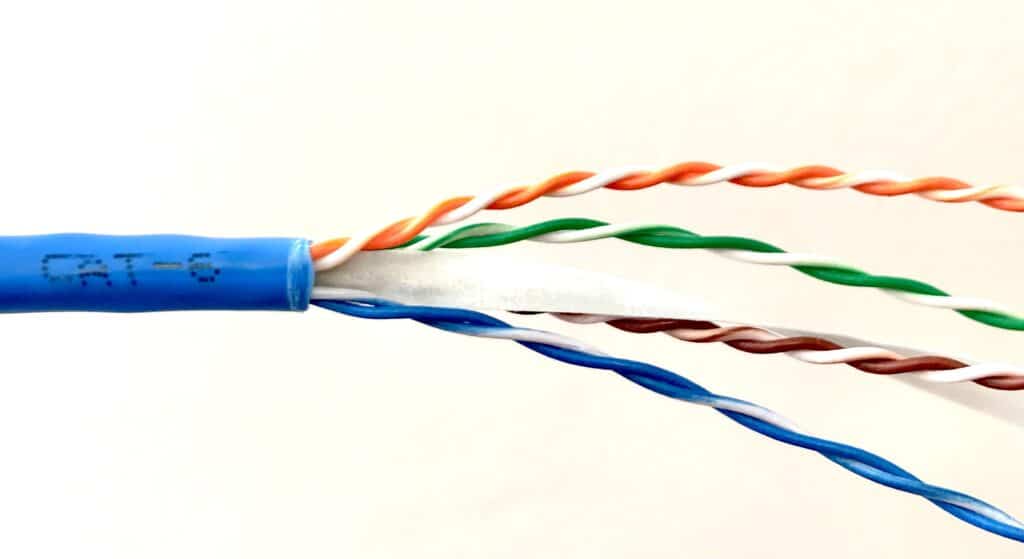
Cat6 or Category 6 is considered the best ethernet cable as it supports even higher bandwidths than Cat5e cables. Cat6 was ratified a few years later than Cat5e. These 23-gauge twisted pair ethernet cables are tightly wound with foil or braided shielding.
The wrapped shielding protected the twisted wire pairs and helped eliminate crosstalk and noise interference. Like Cat5e, Cat6 cables support Gigabit ethernet distances of 100 meters and support speeds to almost 10Gbps for up to 55 meters. They are a bit more expensive than Cat5e and its previous variant. However, they were also used as the backbone of the framework between routers and switches.
Cat5e vs. Cat6 – Speed?
Visually, the Cat5e and Cat6 have the same physical aspects (twisted-pair cables minus the spline inside the twisted pairs in Cat6) that work perfectly for businesses as they support RJ45 end-connectors. Be aware of STP (Shielded Twisted Pair) and UTP (Unshielded Twisted Pair) acronyms associated with these cables. Ensure you know what they are and what they entail to purchase the best ethernet cable for your business.
The speed of Cat5e and Cat6 are the same when compared to their maximum length of 100 meters. At 100 meters, both the cables perform max at 1GBPS transfer speeds. Where’s the difference, then?
If your office requires high bandwidth with fast connections, Cat6 is the best option with its shorter cable length of 55 meters. At 55 meters, Cat6 performs up to a speed of 10Gbps. You may require a fast and reliable connection for your office needs where users can transfer lots of data simultaneously; Cat6 is more suitable for such conditions.
Cat5e vs. Cat6 – Bandwidth?
We have already mentioned that Cat5e and Cat6 have a transfer speed of 1Gbps per second. Although we also mentioned the difference between their cable sizes, there is much significant difference that will clear up any remaining similarities between the two category cables.
The difference is between Cat5e and Cat6 ethernet cable’s bandwidth. Cat5e has a 100MHz operating frequency, while Cat6 has almost 250MHz. It means that Cat5e processes less data than Cat6 at the same time.
Think of the difference as 2-lane and 4-lane straight roads. Both the roads enable a driver to drive at the same speed, but the 4-lane (Cat6) can handle far more vehicles and traffic simultaneously as compared to the 2-lane (Cat5e).
For more info on how much bandwidth you need for your business, check out One Ring Networks awesome Bandwidth Calculator.
Cat5e vs. Cat6 – Crosstalk?
Both the twisted-pair cables use copper wires, which contain four twisted pairs per cable. Although Cat5e has improved shielding than Cat5, Cat6 adheres to even stringent crosstalk and noise elimination standards.
Before, Cat6’s maximum performance was achieved through nylon splines in the wiring. Nylon splines isolated the 4 twisted pairs and made them rigid. But now, they are more flexible with multiple methods to eliminate noise and crosstalk.
The difference is clear. The best ethernet cable must possess better standards of internal interference mitigation. Cat6 wins in this category when bought with splines and shielding included in the wires.
Plenum vs. Riser Ethernet Cable
I will briefly mention two other types of cable. CMP and CMR cables. These acronyms stand for Communications Multipurpose Cable in Plenum (P) or Riser (R). Riser cable is your standard everyday cable whereas plenum cable is more expensive due to its fire-retardant jacket on the cable. Plenum cable by code should be installed in a plenum space.
Cat5e vs. Cat6 – Cost?
Cat6 comes at a slightly higher price than Cat5e. With all its advantages though, the best ethernet cable proves its actual value for the money you spend on it. Unlike most things these days.
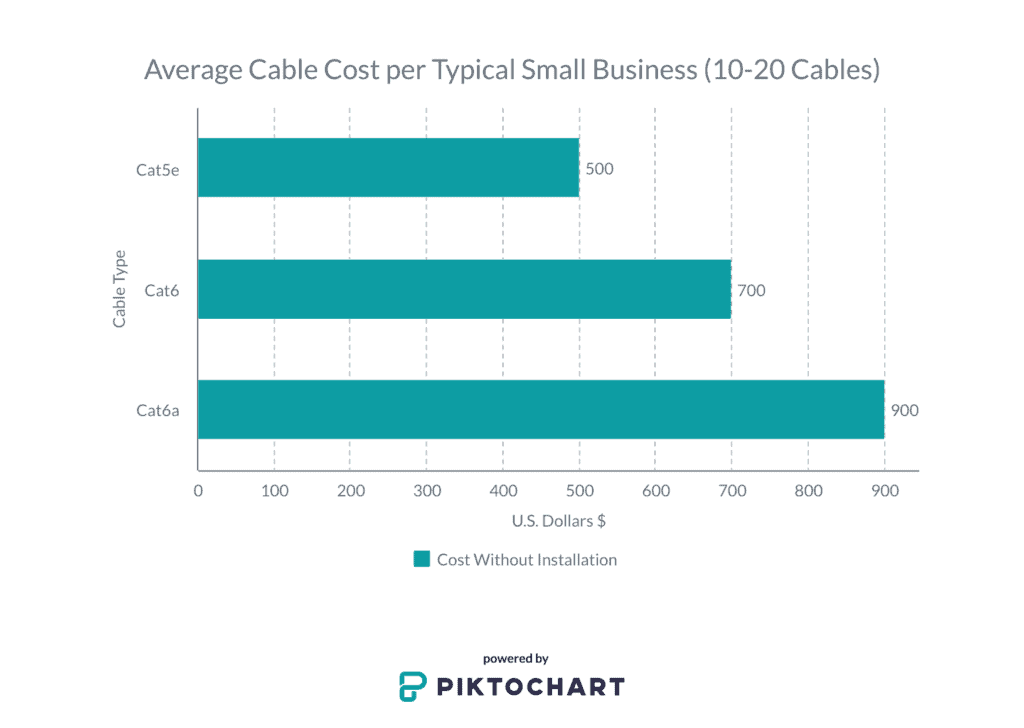
The Cat5e and Cat6 ethernet cables’ prices differ based on length, quality, copper saturation, type, etc. Cat6 cables cost fairly (20 to 40%) more than Cat5e cables. Usually, Cat5e cables are cheaper and sufficient but Cat6 cables are definitely worth the money for their high speed and data transmission.
Cat6a Ethernet Cable
Now that we have discussed Cat5e and Cat6 in detail let’s talk a bit about Cat6a. The Cat6a stands for Augmented Category 6 ethernet cables. These cables are the next variant of the Cat6 cables and have two times more bandwidth.
With 10 Gigabits of speed, Cat6a is backward compatible with all the previously existing standards. Unlike Cat6 and Cat5e, Cat6a can maintain higher data transmission speed over extended cable lengths.
Cat6a cables are shielded twisted pairs, and their shield is quite thick, allowing maximum elimination of crosstalk and noise reduction. Cat6a is more rigid and optimal for achieving high-speed network connections and higher bandwidth-concentrated apps due to its thickness.
Companies with storage network areas, data centers, etc., require such high 10 Gigabits and 500 MHz transmission performance.
Fiber Optic Cable
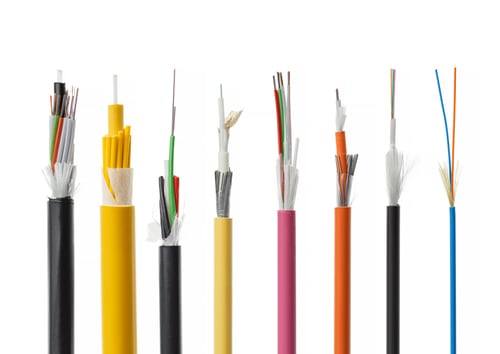
Photo: Shutterstock by Artush
Fiber optic cables are the backbone cabling systems that provide connection in all premises of the office. From your office desk to the ground floor level, the backbone cabling system ensures that every device within the premises remains connected to a fast, reliable connection.
Fiber optic cabling is far faster than the ethernet cables we discussed. This dependable cabling system is best suited for companies that need to share complex and critical data daily.
The composition of a fiber optic cable involves hair-line filaments made from molten silica glass. Fiber optic cables offer numerous benefits falling under the category of single-mode and multimode.
The top advantage is that they can perform well even on longer distances. Plus, they eliminate the minimal electrical interference and disturbances caused during data transmission, taking less space in cable pathways.
Fiber optic cables also provide massive bandwidth and transmission speed, including 10 Gigabit Ethernet speed at 550 meters in multimode fiber. In contrast, Singlemode enables 10 Gigabits Ethernet speed at 40,000 meters.
Conclusion- Cat5e vs. Cat6, Which is the Best Ethernet Cable for Your Business?

Photo: Shutterstock by FS Stock
To choose the best ethernet cable, there are lots of factors to consider. Answer the questions:
- What network speed does your office require? 1 Gbps? 10 or 100 Gbps?
- What will be the number of users or employees? For more users, the frequency (MHz) matters.
- The size of files you are downloading and/or transferring.
- Is there a plenum environment?
All these questions need proper analysis to find the best ethernet cable for your business.
Our personal opinion is in support of Cat6 as it provides more benefits than Cat5e. Faster data transmissions, durability, better crosstalk, and inner noise cancellation. People often consider purchasing high-performance cables are not worth the investment as their office infrastructure does not require such high speeds.
But the point is, the hardware is easier to upgrade over time than to set up new cables in your office. The price difference between Cat5e and Cat6 is not as significant, which makes Cat6 a better-suited ethernet cable.
This way, you will be preparing your network framework for future upgrades without worrying about cabling setups. No matter which ethernet cable you choose for your office’s network infrastructure between Cat5e, Cat6, Cat6a, or fiber optic cables, you should always consider purchasing a pure copper quality cable.
Never compromise on the quality of your ethernet cable. The best ethernet cable should be made with 100% copper material. This is because low-quality cables can cause up to 70% of network downtime due to their extreme crosstalk and improper insulation to reduce inner noise.
Don’t waste your money on a cabling system that degrades over time and proves to be a failure due to deteriorating performance. Consider the supplier you will be purchasing the cabling system from. They matter a lot.
Testing is a huge part of installing the best ethernet cable for your business. Look for suppliers who provide a warranty and Certification of all Cat6 and Cat5e Ethernet cables. In the end, it’s your choice to decide which is the best ethernet cable for your business. So, choose wisely!
READ MORE: Difference between Certification, Verification, and Qualification.
If you’re looking into installing the cable yourself, look into qualifying it properly with the Fluke IQ tester. Poor installation can have a reverse effect on cable performance. The IQ Tester will tell you if you’ve installed it correctly and if it meets the proper industry specs.
For more info or any questions about your upcoming project, please contact us here.
